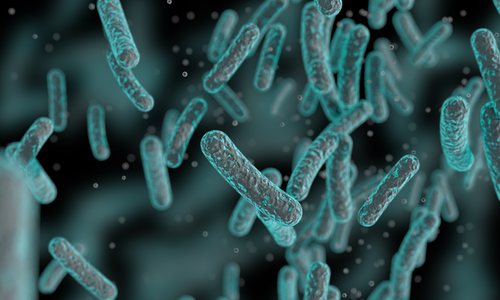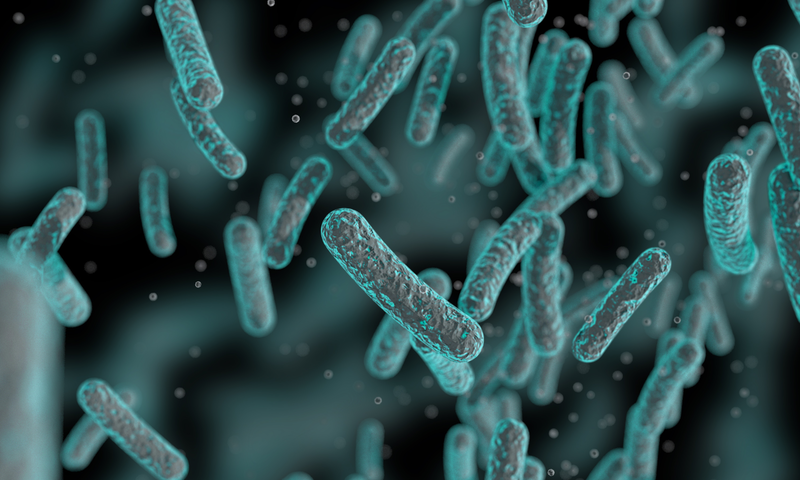How 1000 Bacterial Species Can Coexist
In the bodies of humans and other animals, microbes form complex yet highly stable ecosystems. Researchers have been perplexed by this stability, but now two physicists have used a mathematical model to show that both the complexity and stability of such communities may arise from the way bacteria consume resources. The study suggests that puzzling features of microbial ecosystems may be explained by focusing on the resources that bacteria use, rather than on factors such as how bacteria cooperate or compete.
Biologists have long wondered how bacterial communities can be so stable, given their profound complexity. For example, several hundred species stably coexist in the human gut, even though each species has the potential for fast exponential growth, which could throw the community out of balance. Researchers have also puzzled over the unpredictable makeup of bacterial communities and why two different communities growing in nearly identical environments often end up containing a radically different mix of species.
The explanations for these and other features of microbial communities require a shift in perspective, argue Akshit Goyal of the National Center for Biological Sciences in India and Sergei Maslov of the University of Illinois at Urbana–Champaign. Rather than focusing on competition or cooperation among species, or their responses to environmental changes, the researchers suggest looking instead at the molecular resources that bacteria harvest and how bacterial activity changes the set of resources available over time. Several biologists have previously advocated this point of view, and now Goyal and Maslov present a model that supports it.
The researchers developed a mathematical model of a bacterial community consisting initially of a single species able to exploit a single available resource, such as a particular molecule. When bacteria use a resource, they digest it and then release waste products. These products may well be useful to other bacteria, which may randomly arrive at any time. Each time a new species joins the community, it survives by consuming the waste products from others. In turn, the new species produces new waste products, so the number of resources grows.
Goyal and Maslov assumed that each species can use only a single resource and that its digestion produces two secondary resources. They also assumed that new species occasionally enter the community from outside and then survive only if they can exploit a resource more effectively than any other species already present.
Surprisingly, their simulations showed that the community became more stable as its diversity increased. In principle, if a new species uses a resource more effectively than a species already present, then that older species would go extinct, thereby killing off any species dependent on its waste products or on the products of its dependent species. But the researchers found that such extinction “avalanches” rarely happen in a mature and diverse community. Over time, it becomes increasingly unlikely that a new species entering the community will be more efficient in harvesting its resource than one already present. Diversity and stability naturally grow together, much as biologists see in real microbial ecosystems.
The model also naturally explains why multiple communities that grow under identical conditions can end up being very different. The final mix of species depends sensitively on the historical sequence of species entering the community, the so-called assembly process. A species entering only persists if the resource it needs is present at the time and at levels sufficient for growth, which depends on the earlier presence of several other species.
“Our model is very simple,” says Maslov, “but we think it lays the foundation for a mathematical understanding of how the flow of nutrients affects diversity, stability, and reproducibility of species composition in microbial communities.”
"I really like this work," says ecologist Alvaro Sanchez of Yale University. "The use of simple assembly models for large communities is direly needed, as most microbiomes are highly complex, with often thousands of species.”
The authors note that their current model relies on several simplifying assumptions, for example, that a microbial community starts out with access to only a single resource, and that each species consumes exactly one resource and produces two waste products. However, preliminary tests suggest that the overall outcome is not very sensitive to these details, and the researchers have set out to explore more complex models to further test these ideas.
This research is published in Physical Review Letters.
–Mark Buchanan
Mark Buchanan is a freelance science writer who splits his time between Abergavenny, UK, and Notre Dame de Courson, France.





